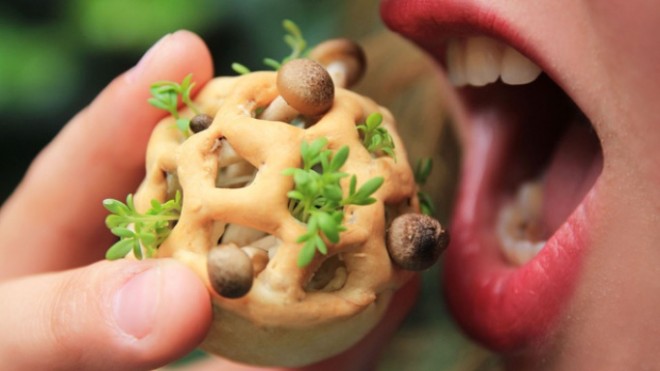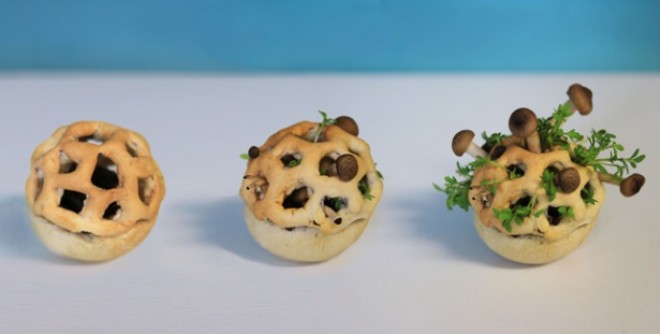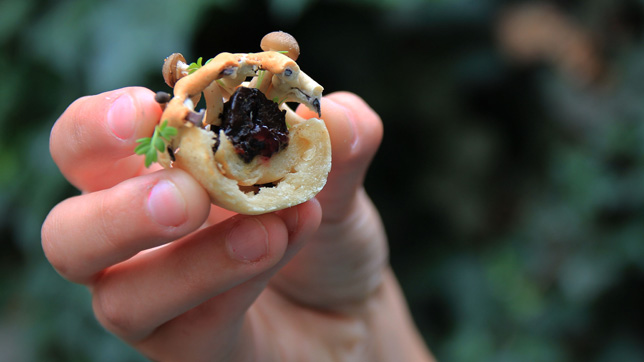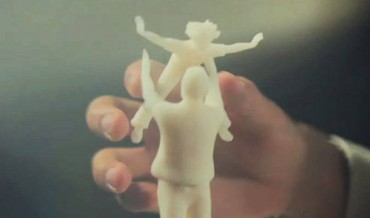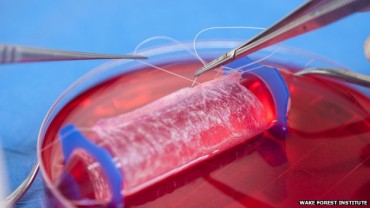Food designer Chloé Rutzerveld has developed a concept for 3D-printed snacks that sprout plants and mushrooms from edible soil housed within a pastry or pasta shell. She envisions a day when your local grocer could print you out a takeaway boxful, and about 4 days later they’ll grow into lunch. In the burgeoning field of futuristic food, these sure beat candy coffee cups.
Her Edible Growth project came about as a form of critical design. Rutzerveld wanted to create lab-produced food that was healthy, natural, and tasty. By combining aspects of nature, science, technology and design, she believes we can create fully natural, healthy, delicious food that is also maximally sustainable.
“By 3D printing food you can make the production chain very short, the transport will be less, there is less land needed,” says Rutzerveld. Her process makes smart use of natural fermentation and photosynthesis, which lower embedded energy requirements, food miles, associated carbon emissions, and food waste. Consumers will become more involved and conscious about the food they eat
 A specific 3D file ‘recipe’ deposits multiple layers of seeds, spores and an edible agar center (a gelatinous substance that acts as a sprouting agent) inside a pastry or pasta structure (also 3D printed). Within five days, plants and fungi mature and yeast ferment the agar into liquid. Similar to cheeses, the product scent and taste intensify over time, and its appearance changes. Depending on the preferred intensity, the consumer decides when to harvest and enjoy the nutrient-rich ‘edible’.
A specific 3D file ‘recipe’ deposits multiple layers of seeds, spores and an edible agar center (a gelatinous substance that acts as a sprouting agent) inside a pastry or pasta structure (also 3D printed). Within five days, plants and fungi mature and yeast ferment the agar into liquid. Similar to cheeses, the product scent and taste intensify over time, and its appearance changes. Depending on the preferred intensity, the consumer decides when to harvest and enjoy the nutrient-rich ‘edible’.
Most supermarket food products are far removed from the farm or ranch. They are highly processed, with origins in laboratory settings. Edible growth is an example of a future food product that bridges authentic practices of growing and breeding food with new technologies, allowing food to stay nearer to its natural state.
“A lot of people think industrialized production methods are unnatural or unhealthy,” Rutzerveld says. “I want to show that it doesn’t have to be the case. You can really see that it’s natural. It’s actually really healthy and sustainable also at the same time.” Her project is more fully explained in a video she made, see below:
[youtube]http://youtu.be/-TgZ5axri80[/youtube]
Until now, most labs have only succeeded in printing sugar sculptures, chocolate and other unhealthy sweets – not basic foods. There are developments in lab-made meats, but not involving 3D technology. Rutzerveld’s project is still in development, and she admits that commercial viability is a long way off. “It will take at least another eight to ten years before this can be on the market,” she concedes.
Microwaves have their critics. Looks like ovens may one day be obsolete too.
Images from Chloé Rutzerveld’s website (link here)

